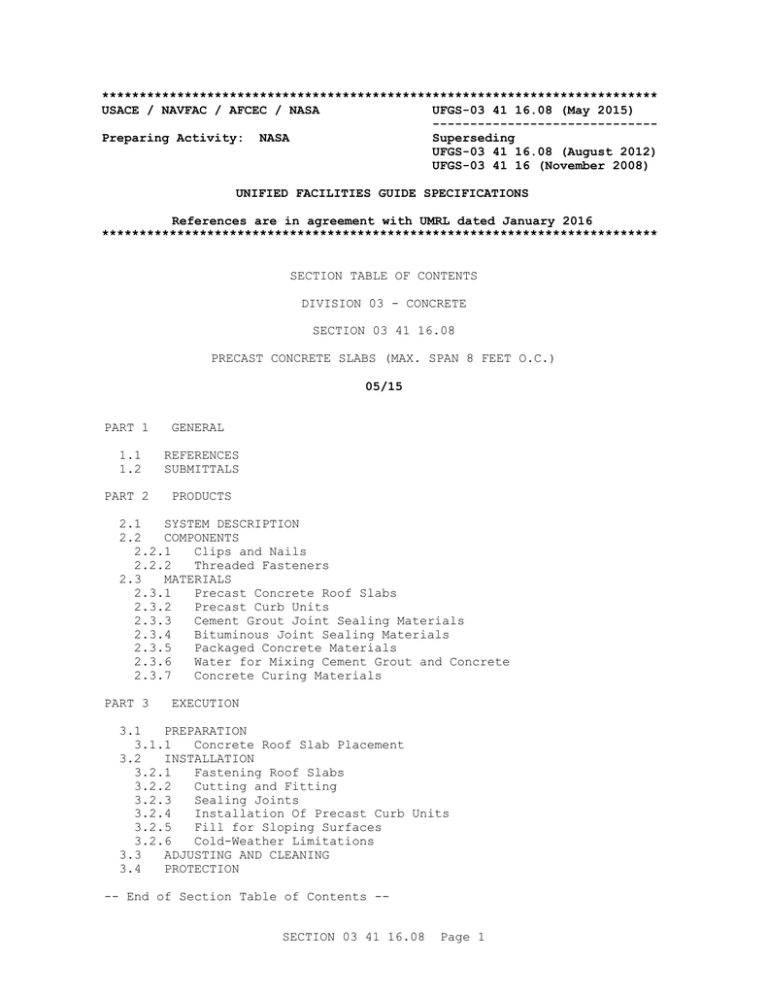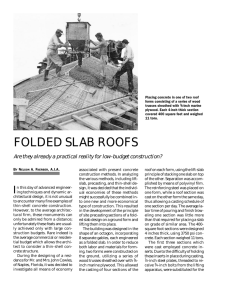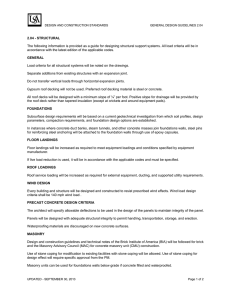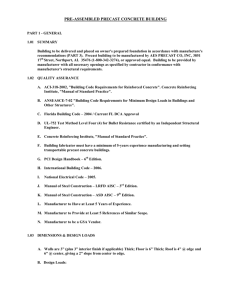************************************************************************** USACE / NAVFAC / AFCEC / NASA ...
advertisement

************************************************************************** USACE / NAVFAC / AFCEC / NASA UFGS-03 41 16.08 (May 2015) -----------------------------Preparing Activity: NASA Superseding UFGS-03 41 16.08 (August 2012) UFGS-03 41 16 (November 2008) UNIFIED FACILITIES GUIDE SPECIFICATIONS References are in agreement with UMRL dated January 2016 ************************************************************************** SECTION TABLE OF CONTENTS DIVISION 03 - CONCRETE SECTION 03 41 16.08 PRECAST CONCRETE SLABS (MAX. SPAN 8 FEET O.C.) 05/15 PART 1 GENERAL 1.1 1.2 REFERENCES SUBMITTALS PART 2 PRODUCTS 2.1 SYSTEM DESCRIPTION 2.2 COMPONENTS 2.2.1 Clips and Nails 2.2.2 Threaded Fasteners 2.3 MATERIALS 2.3.1 Precast Concrete Roof Slabs 2.3.2 Precast Curb Units 2.3.3 Cement Grout Joint Sealing Materials 2.3.4 Bituminous Joint Sealing Materials 2.3.5 Packaged Concrete Materials 2.3.6 Water for Mixing Cement Grout and Concrete 2.3.7 Concrete Curing Materials PART 3 EXECUTION 3.1 PREPARATION 3.1.1 Concrete Roof Slab Placement 3.2 INSTALLATION 3.2.1 Fastening Roof Slabs 3.2.2 Cutting and Fitting 3.2.3 Sealing Joints 3.2.4 Installation Of Precast Curb Units 3.2.5 Fill for Sloping Surfaces 3.2.6 Cold-Weather Limitations 3.3 ADJUSTING AND CLEANING 3.4 PROTECTION -- End of Section Table of Contents -SECTION 03 41 16.08 Page 1 SECTION 03 41 16.08 Page 2 ************************************************************************** USACE / NAVFAC / AFCEC / NASA UFGS-03 41 16.08 (May 2015) -----------------------------Preparing Activity: NASA Superseding UFGS-03 41 16.08 (August 2012) UFGS-03 41 16 (November 2008) UNIFIED FACILITIES GUIDE SPECIFICATIONS References are in agreement with UMRL dated January 2016 ************************************************************************** SECTION 03 41 16.08 PRECAST CONCRETE SLABS (MAX. SPAN 8 FEET O.C.) 05/15 ************************************************************************** NOTE: This guide specification covers the requirements for flat-shaped or channel-shaped roof slabs, max. span 8 feet o.c. placed over purlins or joists spaced not more than 2.5 meter 8 feet on center that receive insulation board and built-up roofing. Include on the drawings, the following: Complete design indicating the character of the work to be performed and giving the roof framing, type, and sizes of purlins or joists, thrust angles at walls, bearing angles at ridges for sloping roofs, end bearing plates, dimensions of roof slab units, details of precast cant units, details of cast-in-place concrete cants and other sloping surfaces, details of openings, and sufficient dimensions to convey adequately the quantity and nature of the required roof decking. Assumed loads and other design data as may be required for the proper preparation of shop drawings. Precast concrete slabs for clear spans exceeding 2.5 meter 8 feet are specified in Section 03 41 33 PRECAST STRUCTURAL PRETENSIONED CONCRETE. A structural steel roof framing system, including steel purlins and framing for openings larger than 1/2 width of roof slabs in any dimension, is specified in Section 05 12 00 STRUCTURAL STEEL. An open-web steel joist roof framing system is specified in Section 05 21 00 STEEL JOIST FRAMING. Fire resistance-rated roof and ceiling constructions using precast concrete roof decking are described in Underwriters Laboratories, Inc., "Fire Resistance Ratings (BXUV)" contained in UL FRD and the "Fire Resistance Ratings" contained in AIA CO-1. Fire SECTION 03 41 16.08 Page 3 resistance rated construction limits the type and spacing of the roof framing system; type of roof slab units and method of fastening the roof slabs to the supporting frame; ceiling construction; and roof construction. Adhere to UFC 1-300-02 Unified Facilities Guide Specifications (UFGS) Format Standard when editing this guide specification or preparing new project specification sections. Edit this guide specification for project specific requirements by adding, deleting, or revising text. For bracketed items, choose applicable items(s) or insert appropriate information. Remove information and requirements not required in respective project, whether or not brackets are present. Comments, suggestions and recommended changes for this guide specification are welcome and should be submitted as a Criteria Change Request (CCR).. ************************************************************************** PART 1 1.1 GENERAL REFERENCES ************************************************************************** NOTE: This paragraph is used to list the publications cited in the text of the guide specification. The publications are referred to in the text by basic designation only and listed in this paragraph by organization, designation, date, and title. Use the Reference Wizard's Check Reference feature when you add a RID outside of the Section's Reference Article to automatically place the reference in the Reference Article. Also use the Reference Wizard's Check Reference feature to update the issue dates. References not used in the text will automatically be deleted from this section of the project specification when you choose to reconcile references in the publish print process. ************************************************************************** The publications listed below form a part of this specification to the extent referenced. The publications are referred to within the text by the basic designation only. AMERICAN ASSOCIATION OF STATE HIGHWAY AND TRANSPORTATION OFFICIALS (AASHTO) AASHTO M 182 (2005; R 2012) Standard Specification for Burlap Cloth Made from Jute or Kenaf and Cotton Mats SECTION 03 41 16.08 Page 4 AMERICAN CONCRETE INSTITUTE INTERNATIONAL (ACI) ACI C-21 (1992) Elevated Slabs AMERICAN WOOD PROTECTION ASSOCIATION (AWPA) AWPA BOOK (2012) AWPA Book of Standards ASME INTERNATIONAL (ASME) ASME B18.2.2 (2010) Nuts for General Applications: Machine Screw Nuts, Hex, Square, Hex Flange, and Coupling Nuts (Inch Series) ASME B18.2.6 (2010; Supp 2011) Fasteners for Use in Structural Applications ASME B18.21.1 (2009) Washers: Helical Spring-Lock, Tooth Lock, and Plain Washers (Inch Series) ASME B18.22M (1981; R 2010) Metric Plain Washers ASME B18.6.3 (2013) Machine Screws, Tapping Screws, and Machine Drive Screws (Inch Series) ASME B18.6.7M (1999; R 2010) Metric Machine Screws ASTM INTERNATIONAL (ASTM) ASTM C150/C150M (2015) Standard Specification for Portland Cement ASTM C171 (2007) Standard Specification for Sheet Materials for Curing Concrete ASTM C33/C33M (2013) Standard Specification for Concrete Aggregates ASTM C387/C387M (2015) Standard Specification for Packaged, Dry, Combined Materials for Mortar and Concrete ASTM C514 (2004; R 2014) Standard Specification for Nails for the Application of Gypsum Board ASTM C595/C595M (2015; E 2015) Standard Specification for Blended Hydraulic Cements ASTM C618 (2012a) Standard Specification for Coal Fly Ash and Raw or Calcined Natural Pozzolan for Use in Concrete ASTM C989/C989M (2014) Standard Specification for Slag Cement for Use in Concrete and Mortars ASTM D312/D312M (2015) Standard Specification for Asphalt Used in Roofing SECTION 03 41 16.08 Page 5 Installation Drawings[; G[, [____]]] SD-03 Product Data Clips[; G[, [____]]] Nails[; G[, [____]]] Threaded Fasteners[; G[, [____]]] Joint Sealing Compounds[; G[, [____]]] Precast Concrete Roof Slabs[; G[, [____]]] Precast Curb Units[; G[, [____]]] Packaged Concrete Materials[; G[, [____]]] Absorption Cover[; G[, [____]]] Moisture-Retaining Cover[; G[, [____]]] SD-05 Design Data Design Analysis[; G[, [____]]] Calculations[; G[, [____]]] SD-06 Test Reports Nail Driving and Nail Pulling Tests[; G[, [____]]] Strength Tests[; G[, [____]]] SD-07 Certificates Precast Concrete Roof Slabs[; G[, [____]]] Precast Curb Units[; G[, [____]]] Clips[; G[, [____]]] Nails[; G[, [____]]] Threaded Fasteners[; G[, [____]]] Cement Grout Joint Sealing Materials[; G[, [____]]] Bituminous Joint Sealing Materials[; G[, [____]]] SD-08 Manufacturer's Instructions Installation Instructions[; G[, [____]]] SECTION 03 41 16.08 Page 7 Installation Drawings[; G[, [____]]] SD-03 Product Data Clips[; G[, [____]]] Nails[; G[, [____]]] Threaded Fasteners[; G[, [____]]] Joint Sealing Compounds[; G[, [____]]] Precast Concrete Roof Slabs[; G[, [____]]] Precast Curb Units[; G[, [____]]] Packaged Concrete Materials[; G[, [____]]] Absorption Cover[; G[, [____]]] Moisture-Retaining Cover[; G[, [____]]] SD-05 Design Data Design Analysis[; G[, [____]]] Calculations[; G[, [____]]] SD-06 Test Reports Nail Driving and Nail Pulling Tests[; G[, [____]]] Strength Tests[; G[, [____]]] SD-07 Certificates Precast Concrete Roof Slabs[; G[, [____]]] Precast Curb Units[; G[, [____]]] Clips[; G[, [____]]] Nails[; G[, [____]]] Threaded Fasteners[; G[, [____]]] Cement Grout Joint Sealing Materials[; G[, [____]]] Bituminous Joint Sealing Materials[; G[, [____]]] SD-08 Manufacturer's Instructions Installation Instructions[; G[, [____]]] SECTION 03 41 16.08 Page 7 PART 2 2.1 PRODUCTS SYSTEM DESCRIPTION Submit fabrication drawings for precast concrete deck units. On the drawings, provide dimensions, size, and number of openings to be cut. Provide and submit installation drawings for precast concrete roof slabs and cast-in-place curb units. On the drawings, provide details and layouts indicating structural framing, location and length of concrete slabs corresponding with the sequence and procedure to be followed in placing and fastening roof slabs, and location and type of fasteners. Ensure that drawings also show details of curb units indicating location of cants, crickets, drainage saddles, and other sloping surfaces. 2.2 2.2.1 COMPONENTS Clips and Nails Use zinc- or cadmium-plated steel strip clips, not less than 0.76 millimeter 0.0299-inch thick (manufacturer's standard 0.76 millimeter) 22-gage. Ensure clips are formed to fit the top flange of steel beam purlins or steel joists having steel angle top chords, and of design recommended by the precast concrete roof slab manufacturer. Use roofing nails that are 32 millimeter 1-1/4-inches long, galvanized steel, conforming to ASTM C514, Type II, Style 20. Submit manufacturer's catalog product data for clips and nails. Submit certificates of compliance for clips and nails showing conformance with referenced standards contained in this section. 2.2.2 Threaded Fasteners Provide fasteners that consist of machine screws, nuts, and washers. Use slotted, flathead, galvanized, carbon steel machine screws conforming to ASME B18.6.7M ASME B18.6.3, Type I, Style 2s. Use hexagon, galvanized, carbon steel nuts conforming to ASME B18.2.6 ASME B18.2.2, Type II, Style 10. Provide round-type, galvanized, carbon steel, general-purpose assembly washers conforming to ASME B18.22M ASME B18.21.1, Type A, Grade I, Class A. Submit manufacturer's catalog product data for threaded fasteners. Submit certificates of compliance for threaded fasteners showing conformance with referenced standards contained in this section. 2.3 MATERIALS ************************************************************************** NOTE: Indicate precast-concrete roof slab dimensions. ************************************************************************** SECTION 03 41 16.08 Page 8 2.3.1 Precast Concrete Roof Slabs ************************************************************************** NOTE: Delete the following paragraphs when channel roof slabs are required. ************************************************************************** Provide installation instructions that indicate the manufacturer's recommended installation methods and sequence. Provide manufacturer's catalog data for all accessories including nails, threaded fasteners, and joint sealing compounds. Submit design analysis and calculations for precast concrete roof slabs. Submit certificates of compliance for precast concrete roof slabs showing conformance with referenced standards contained in this section. Submit test reports for precast concrete roof slabs regarding nail driving and nail pulling tests and strength tests in accordance with ACI C-21. ************************************************************************** NOTE: Delete when using channel roof slab. ************************************************************************** Ensure roof slabs are flat or plank-shaped and conform to ACI C-21, Type I or Type II, with the following modifications: a. Ensure flat slabs have wire mesh reinforcing in both top and bottom of the slab. b. Slabs have nailing edges. ************************************************************************** NOTE: Delete one of the following two paragraphs as applicable to the project. When spacing of the structural framing members is less than 1.5 meter 5-feet, delete the first of the following paragraphs. When spacing of the structural framing members exceeds 1.5 meter 5-feet, delete the second of the following paragraphs. ************************************************************************** c. Ensure flat slabs have tongue-and-groove edges on sides and square edges on ends, except that edges for exposed roof sides are square. d. Ensure flat slabs have tongue-and-groove edges on sides and ends, except that edges for exposed roof sides and ends are square. ************************************************************************** NOTE: Delete the following paragraphs when flat or plank roof slabs are required. ************************************************************************** Use channel shaped precast concrete roof slabs conforming to ACI C-21, Type I or Type II, with the following modifications: a. Reinforce channel slabs with steel-wire mesh in the web section and one 12.7 millimeter No. 4 steel reinforcing bar in each flange. SECTION 03 41 16.08 Page 9 b. Ensure slabs have nailing edges. ************************************************************************** NOTE: The following paragraph applies to both flat and channel roof slabs. ************************************************************************** c. [2.3.2 Ensure that roof slabs, not suitable for nailing, have wood inserts. Pressure treat wood using a water-borne preservative and attain the minimum net retention of the solid preservative for lumber used in protected locations, in accordance with AWPA BOOK. Ensure that inserts are at least 50 by 75 millimeter (nominal), 37.5 by 62.5 millimeter(dressed) 2-by 3-inches (nominal), 1.5-by 2.5-inches(dressed), in section, placed in rows on 600 millimeter 24-inches on center, and parallel with the roof slope. Ensure inserts are set flush with surfaces of slabs and rigidly secured in place with anchors designed and spaced to provide the holding strength required for subsequent nailing of roofing. Precast Curb Units ************************************************************************** NOTE: Delete paragraph heading and the following paragraphs when precast curb units, such as curbs for vents, skylights, and other units not in the same plane as the roof decking, are not required. ************************************************************************** Construct curb units of the same material, reinforce for same strength requirements as precast concrete roof slabs. Design precast curb units to fit securely in the anchorage provided by structural framing members. Submit manufacturer's catalog data for all accessories including nails, threaded fasteners, and joint sealing compounds. Submit certificates of compliance for precast curb units showing conformance with referenced standards contained in this section. ]2.3.3 Cement Grout Joint Sealing Materials [ Provide blended hydraulic cement that conforms to ASTM C595/C595M, Type [_____]. ][Provide portland cement that conforms to ASTM C150/C150M, Type I. ] Ensure that aggregate for cement grout is clean, sharp, uniformly graded, natural or manufactured sand conforming to ASTM C33/C33M. Submit manufacturer's catalog product data for cement grout joint sealing materials. Submit certificates of compliance for precast curb units showing conformance with referenced standards contained in this section. 2.3.4 Bituminous Joint Sealing Materials Provide bituminous cement that is steep asphalt for use in constructing built-up roof coverings conforming to ASTM D312/D312M, Type IV. SECTION 03 41 16.08 Page 10 Compose joint-sealing tape of two layers of uncreped kraft paper united by steep asphalt with approximately 13 by 8 millimeter 1/2- by 1/3-inch glass-fiber reinforcement embedded in the asphalt laminate. Tape to meet requirements of FS UU-B-790, Type I, Grade C, Style 4, with the following modifications: a. Ensure that width is 150 millimeter 6-inches. b. Dry tensile strength cannot be less than 6150 newton per meter 35 pounds per inch width, both directions. Submit manufacturer's catalog product data for bituminous joint sealing materials. Submit certificates of compliance for bituminous joint sealing materials showing conformance with referenced standards contained in this section. 2.3.5 Packaged Concrete Materials Ensure that concrete materials are packaged, dry, combined materials for concrete conforming to ASTM C387/C387M, lightweight concrete (using natural sand), and have the following properties: Property Value Compressive strength at 28 days Not less than 20 Megapascal Maximum aggregate size 9.5 millimeters Slump Not more than 75 millimeters Total air content by volume Not less than 6 nor more than 10 percent Property Value Compressive strength at 28 days Not less than 3,000 psi Maximum aggregate size 3/8-inch Slump Not more than 3-inches Total air content by volume Not less than 6 nor more than 10 percent ************************************************************************** NOTE: Ground granulated blast-furnace slag is one of the materials listed in the EPA's Comprehensive Procurement Guidelines (CPG) (http://www.epa.gov/cpg/). If the Architect/Engineer determines that use of certain materials meeting the CPG content standards and guidelines would result in inadequate competition, do not meet quality/ performance specifications, are available at an unreasonable price or are not available within a reasonable time frame, the Architect/Engineer may submit written justification SECTION 03 41 16.08 Page 11 and supporting documentation for not procuring designated items containing recovered material. Submit written justification on a Request for Waiver Form to the NASA Environmental Program Manager for approval. The Request for Waiver Form is located in the NASA Procedures and Guidelines (NPG 8830.1) ( http://nodis3.gsfc.nasa.gov). ************************************************************************** [ Ensure that materials used as ingredients include: [Blended hydraulic cement conforming to ASTM C595/C595M] [Fly ash conforming to ASTM C618, Class C or F] [Ground granulated blast furnace slag conforming to ASTM C989/C989M, [Grade 120.]] ] Provide manufacturer's catalog product data for packaged concrete materials. 2.3.6 Water for Mixing Cement Grout and Concrete Use potable water for mixing cement grout and concrete. 2.3.7 Concrete Curing Materials Ensure the absorption cover for curing concrete is burlap cloth made from jute or kenaf, conforming to AASHTO M 182, Class 3. Ensure the moisture-retaining cover for curing concrete is white waterproof paper or white opaque polyethylene sheet conforming to ASTM C171. Provide manufacturer's catalog product data for absorption covers and moisture-retaining covers. PART 3 EXECUTION Install precast roof slabs and accessories in accordance with the approved drawings and as specified. 3.1 PREPARATION Ensure the supporting walls, purlins or joists, and other supporting members are in place before the placing of precast roof slabs is started. Do not place roof slabs during, or while there is a threat of, rain or snow. 3.1.1 Concrete Roof Slab Placement Place each roof slab on structural framework to bear on at least two structural framing members. Ensure that end bearing is not less than 50 millimeter 2-inches. For roof slabs having square edges, ensure the ends occur over a structural framing member. Where installation requires cutting roof slabs, ensure the cut ends occur over supports at the wall or at openings. Cut roof slabs as specified. ************************************************************************** NOTE: Delete following paragraph when the spacing of the structural framing members exceeds 1.5 meter 5-feet, or when flat slabs having tongue-and-groove edge on ends are not required. ************************************************************************** SECTION 03 41 16.08 Page 12 Ends of roof slabs having tongue-and-groove edges on ends do not need to occur over a structural framing member; stagger such end joints in adjacent rows. Align roof slabs in each row end to end, with adjacent rows parallel. Alignment does not depend on adjacent walls or structural framing members being accurately square. 3.2 3.2.1 INSTALLATION Fastening Roof Slabs Fasten roof slabs to each structural framework member by means of clips and nails. Where possible, alternate clips in position so that each clip is facing in the opposite direction of the next clip. Secure clips to roof slabs with one nail per clip and fit to the top flange or chord of structural framework member by slots in the clips formed for this purpose. When the roof slope is greater than a 1 to 4 ratio, fasten roof slabs to supporting members by threaded fasteners in addition to the clips specified. Ensure that threaded fasteners are not less than 13 millimeter 1/2-inch in diameter. Use countersunk fastener heads. Attach fasteners to the top flange or chord of supporting members by means of offset clips or other approved method. Ensure that threaded fasteners are not less than one fastener per 3 square meter 30 square feet of roof area. 3.2.2 Cutting and Fitting ************************************************************************** NOTE: Frame openings in precast roof slabs larger than one-half the roof slab width in any dimension with supporting members that are provided as a part of the roof framing system. ************************************************************************** Perform roof slab cutting and fitting as required by the approved drawings for passage of other work projecting through or adjacent to the roof decking. Ensure the cuts are straight and clean through roof slabs and at 90 degrees to severed surfaces without breaking, spalling, or appreciable crumbling at edges. 3.2.3 Sealing Joints After roof slabs have been placed and fastened, seal the top portion of joints as specified. Fill joints at ridges and hips and tongue-and-groove joints with cement grout. Provide cement grout that consists of portland cement, sand, and water mixed to manufactures instructions. Place grout so as to be even with the top surface of roof slabs. Remove excess grout and give grout surface a smooth finish. Seal other joints with specified bituminous joint sealing materials. Center joint sealing tape over the joint and embedded in hot bituminous cement applied at the rate of 6 to 8 kilogram per 10 square meter 15 to 20 pounds per 100 square feet of joint sealing tape. Provide end laps that are less than 100 millimeter 4 inches. Remove excess bitumen and ensure that the joint sealing tape surface is smooth and free of wrinkles. SECTION 03 41 16.08 Page 13 3.2.4 Installation Of Precast Curb Units ************************************************************************** NOTE: Delete paragraph heading and following paragraph when precast curb units are not required. ************************************************************************** Install precast curb units in accordance with approved drawings. 3.2.5 Fill for Sloping Surfaces Ensure that fill for curb cants and other sloping surfaces consists of the specified packaged concrete materials mixed with water. Mix concrete either manually or by mechanical mixer, using the quantity of water indicated on packaged concrete materials. Accurately measure water used in manual mixing. Equip mechanical mixer with a device to measure and control the amount of water used. Keep mixer drums, mixing boxes, tools, and other mixing equipment clean and free from hardened lumps of concrete. Handle concrete mixture from the point of mixing and transferred to concrete conveying equipment and to locations of final deposit as rapidly as possible by methods that prevent segregation and loss of concrete mix materials. Ensure that mechanical equipment for conveying concrete mixtures is of such size and design as to ensure a uniform, continuous flow of concrete mixture at the delivery end. For concrete conveying equipment, maintain the inner surfaces free of hardened concrete, debris, water, snow, ice, or other deleterious materials. Place and screed concrete mixture in a continuous operation until placing a section is completed. Ensure the finished surface is free of humps or hollows; sloped to drains; uniform, smooth, even plane; and of granular texture. Immediately following the concrete finishing operation, ensure the concrete is kept continuously moist for at least 72 hours by covering the concrete surface with a specified absorptive cover for curing concrete, or kept continuously wet, by covering concrete surface with a specified moisture-retaining cover for curing concrete, or by a combination of both curing methods. During the concrete curing period, protect concrete from damage caused by rain or running water, by excessively cold or hot temperatures, and from damaging mechanical disturbances. 3.2.6 Cold-Weather Limitations Do not perform joint sealing, concrete mixing, or placing when the ambient temperature is 5 degrees C 40 degrees F or below. 3.3 ADJUSTING AND CLEANING Upon completion of roof decking work, sweep roof surfaces clean of debris and other foreign matter and in a condition ready to receive roofing. 3.4 PROTECTION SECTION 03 41 16.08 Page 14 Protect finished roof decking from damage by weather and construction operations until roofing is installed. -- End of Section -- SECTION 03 41 16.08 Page 15




